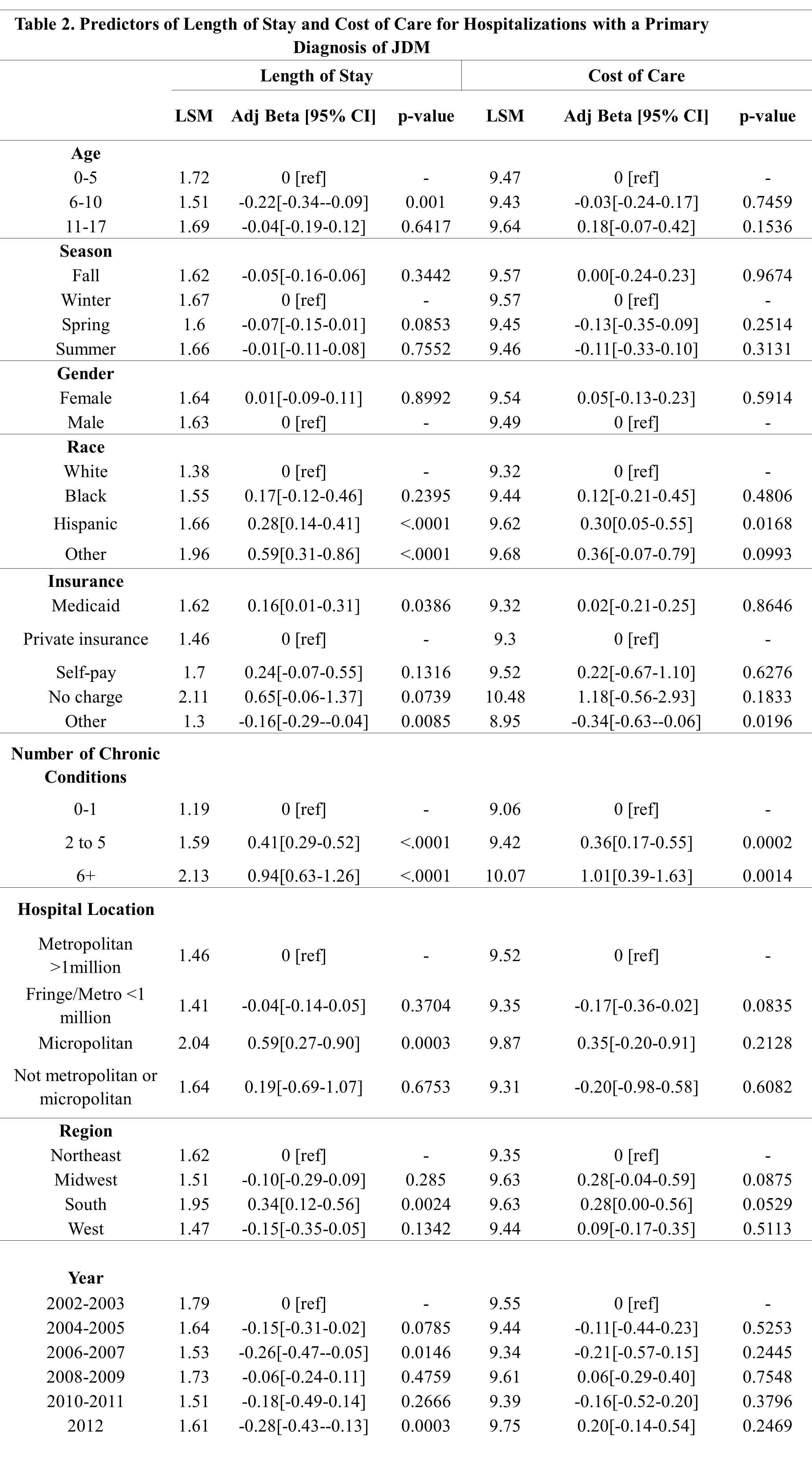Session Information
Date: Wednesday, November 8, 2017
Title: Health Services Research II: Methods and Technology in Care and Research
Session Type: ACR Concurrent Abstract Session
Session Time: 9:00AM-10:30AM
Background/Purpose:
Juvenile dermatomyositis (JDM) is a rare autoimmune disease that causes significant morbidity and quality of life impairment. Little is known about JDM inpatient burden in the US. This study analyzes the prevalence and predictors of hospitalization, length of stay (LOS), and cost of care in US patients with JDM.
Methods:
Data on 14,401,668 pediatric hospitalizations from the 2002-2012 Nationwide Inpatient Sample (NIS), a 20% stratified sample of all acute-care hospitalizations in the US was analyzed. Previously validated ICD-9-CM codes were used to identify hospitalizations with a primary (i.e. condition chiefly responsible for inpatient admission) vs. secondary diagnosis of JDM. The control group included all hospitalizations without any diagnosis of JDM. Survey logistic regression models evaluated predictors of hospitalization for JDM. Adjusted ORs were obtained via multivariate regression including age, sex, race/ethnicity, season, insurance, number of chronic conditions, and hospital location. Linear regression models with log transformed cost of care or LOS evaluated predictors of cost of hospitalization and LOS using the aforementioned covariates.
Results:
There were 909 and 495 weighted admissions with a primary or secondary diagnosis of JDM, respectively. In multivariable analysis, older age, female sex, non-winter season, metropolitan area and Western geographic region, and other types of financial coverage aside from Medicaid and private insurance (i.e. ChildrenÕs Health Insurance Program (CHIP), other federal/state/local government programs) were all associated with higher rates of hospitalization for JDM (Table 1). The weighted total LOS and inflation-adjusted cost of care for patients with a primary diagnosis of JDM was 19,159 days and $49,339,995 with geometric means [95% CI] of 2.50 [2.27-2.76] days and $7,350 [$6,228-$8,674]. LOS in secondary JDM and cost in primary and secondary JDM were significantly higher compared to no JDM. Hispanic and other non-white race/ethnicity were associated with increased LOS (log-linear regression; adjusted beta [95% confidence interval]) (Hispanic: 0.28 [0.14-0.41]; other non-white: 0.59 [0.31-0.86]). Hispanic patients had higher cost of care (0.30 [0.05-0.55]) (Table 2).
Conclusion:
JDM adds to inpatient burden in the US, especially via increased LOS and cost of care. Rates of hospitalization for JDM differed by age, gender, season, form of financial coverage, and geography/region, while Hispanic patients had increased LOS and cost of care.
To cite this abstract in AMA style:
Kwa MC, Silverberg JI, Ardalan K. Predictors of Hospitalization, Length of Stay and Costs of Care Among Children with Juvenile Dermatomyositis in the United States [abstract]. Arthritis Rheumatol. 2017; 69 (suppl 10). https://acrabstracts.org/abstract/predictors-of-hospitalization-length-of-stay-and-costs-of-care-among-children-with-juvenile-dermatomyositis-in-the-united-states/. Accessed .« Back to 2017 ACR/ARHP Annual Meeting
ACR Meeting Abstracts - https://acrabstracts.org/abstract/predictors-of-hospitalization-length-of-stay-and-costs-of-care-among-children-with-juvenile-dermatomyositis-in-the-united-states/


